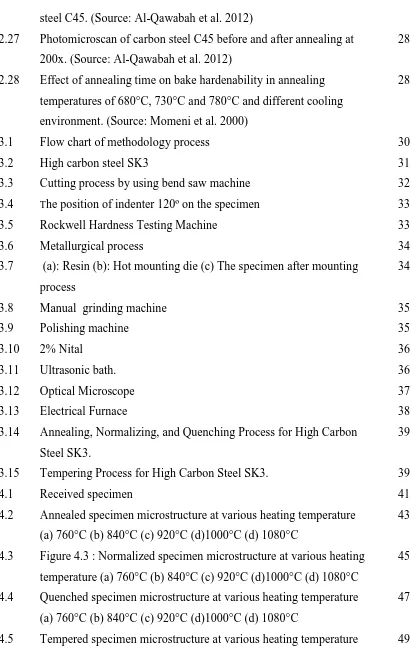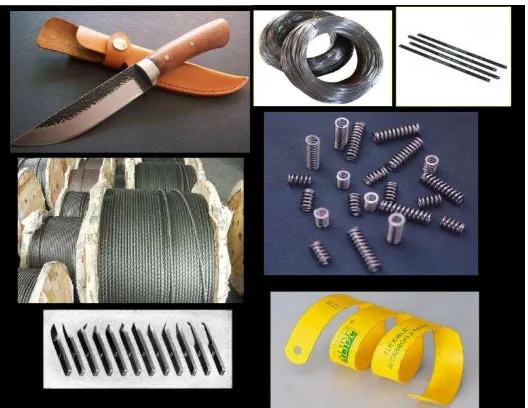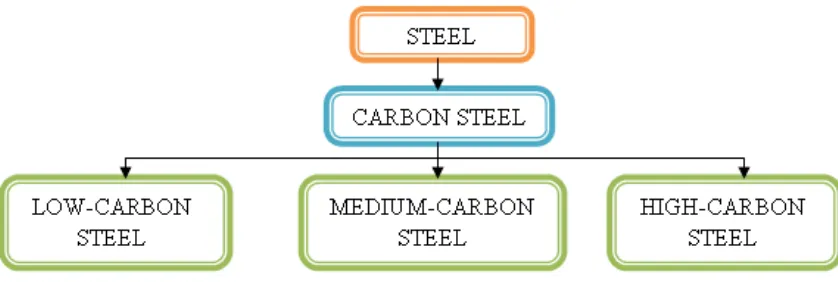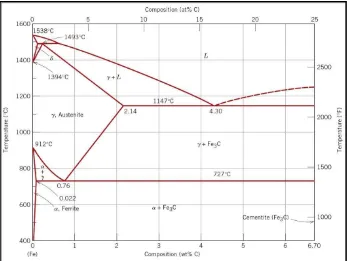EFFECT OF HEAT TREATMENT ON THE MICROSTRUCTURES AND MECHANICAL PROPERTIES OF HIGH CARBON STEEL
IFFA MARINA BT JOPRI
SUPERVISOR DECLARATION
“I hereby declare that I have read this thesis and in my opinion this report is sufficient in terms of scope and quality for the award of the degree of
Bachelor of Mechanical Engineering (Structure and Material)
EFFECT OF HEAT TREATMENT ON THE MICROSTRUCTURES AND MECHANICAL PROPERTIES OF HIGH CARBON STEEL
IFFA MARINA BT JOPRI
Thesis submitted in fulfillment of the requirements for the award of degree
Bachelor of Mechanical Engineering (Structure & Material)
Faculty of Mechanical Engineering Technical University of Malaysia Malacca.
DECLARATION
“I hereby declare that the works in this report is my own except for summaries and
quotations which have been duly acknowledge.
DEDICATION
ACKNOWLEDGEMENT
First of all I am grateful to Allah S.W.T for giving blessing and strong spirit for me to complete my Project Sarjana Muda. I would like to offer my deepest gratitude to Mr. Ridhwan bin Jumaidin from the bottom of heart for all the support, encouragement and inspiration manage to obtain all the way through this Project Sarjana Muda. The excellent working relationship between my supervisor and me has provided me with knowledge and experience for the future. The help rendered to me is priceless. Besides that, I would like to thank Dr. Noreffendy Tamaldin, dean of Faculty of Mechanical Engineering, all lecturers, tutors and technicians especially to Mr. Mahader bin Muhamad whom has guide and helped during an experiment and research process of this project.
ABSTRAK
ABSTRACT
TABLE OF CONTENTS
CHAPTER TITLE PAGE NO.
Declaration Dedication
Acknowledgement Abstrak
Abstract
Table of contents List of tables List of figures
i ii iii iv-vi vii viii-xi
CHAPTER 1 INTRODUCTION 1
1.1 Overview 1
1.1.1 High carbon steel 1
1.1.2 Heat treatment 2
1.2 Problem statement 3
1.3 Objectives 3
1.4 Scope of study 3
CHAPTER 2 LITERATURE REVIEW 4
2.1 Carbon steels 4
2.2 Phase diagram 5
2.2.1 Ferrite 6
2.2.2 Austenite 7
2.2.3 Cementite 7
2.3.1 Annealing 8
2.3.2 Normalizing 9
2.3.3 Quenching 9
2.3.4 Tempering 10
2.4 Effect of heat treatment on microstructures og high carbon steel.
11
2.5 Effect of heat treatment on mechanical properties of high carbon steel.
14
2.6 Effect of quenching process 17
2.7 Effect of tempering treatment process 20
2.8 Effect of cooling rate in treatment 22
2.9 Effect of soaking time in annealing process 26
2.10 Effect of increasing annealing temperatures on microstructures and mechanical properties
27
CHAPTER 3 RESEARCH METHODOLOGY 29
3.1 Overview 29
3.2 Preparation of specimen 31
3.2.1 Raw material 31
3.2.2 Specimen preparation 31
3.3 Material composition 32
3.4 Hardness test 32
3.5 Metallurgical investigation 34
3.6 Heat treatment 37
3.6.1 Annealing , normalizing and quenching process
37
3.7.2 Tempering 38
CHAPTER 4 RESULTS AND DISCUSSION 40
4.1 Composition analysis 40
4.2.1 As-received specimen 41
4.2.2 Annealed specimen 41
4.2.3 Normalized specimen 44
4.2.4 Quenched specimen 46
4.2.5 Tempered specimen 48
4.3 Hardness test 50
4.3.1 Hardness value of as-received specimen
50
4.3.2 Hardness value of various heat treatment
50
4.4 Effect of heating temperature. 51
4.5 Effect of cooling rate 52
4.5.1 Quenched specimen 52
4.5.2 Annealed specimen 53
4.5.3 Normalized specimen 54
4.6 Effect of tempering process 55
CHAPTER 5 CONCLUSION AND RECOMMENDATION 57
REFERENCES 59
LIST OF TABLES
NO. TITLE PAGE
NO.
2.1 The results of tensile test and hardness test with the number of heat
treatment cycles. (Source: Atanu et al. 2010)
16
2.2 Heat treatment process of ultra-high carbon steel.
(Source: Suchanek et al. 2009)
18
2.3 The tested data on different temperature of quenching
and tempering (Source: Liujie et al. 2007)
21
2.4 Chemical composition of AISI 1060 SteelS. (Source: Adnan 2009) 23
2.5 The microhardness valued after various heated treatments of AISI
1060 Steels (Source: Adnan, 2009)
23
2.6 Chemical composition of steels (wt%) (Source: Anjana et al. 2012) 24
2.7 Temperatures and soaking time for annealing process
(Source: Al-Qawabah et al. 2012)
27
3.1 Description data of specimen 31
3.2 Hardness test specification on high carbon steel 33
3.3 Heating and cooling method 37
4.1 As-receive material hardness value 50
LIST OF FIGURES
NO. TITLE PAGE
NO.
1.1 High carbon steel application in industry. 2
2.1 Carbon steel chart 4
2.2 The iron-iron carbide phase diagram (Source: Kalpakjian et al.
2010)
6
2.3 Unit cells for autenite, ferrite and martensite. (Source: Kalpakjian et
al. 2010)
7
2.4 Time-Temperature Paths on Isothermal Transformation Diagram.
(Source: sv.vt.edu)
10
2.5 Tempered at 600°C : (a) with cooper (b) without cooper. (Source:
Motagi et al. 2012)
11
2.6 Fine cementite particles. (Source: Atanu et al. 2012) 12
2.7 Pearlite was formed around the cementite. (Source: Zhang et al.
2008)
12
2.8 Optical micrograph of the specimen : (a) as receive (b) 9%
undissolve cementite in martensite matrix
13
2.8 Optical micrograph of the specimen : (c) 5% undissolve cementite in
martensite matrix. (d) 1% undissolve cementite in martensite matrix. (Source : Kyong et al. 2007)
14
2.9 Variation of ultimate tensile Strength against tempering temperature
(Source: Motagi et al. 2012)
14
2.10 Variation of % elongation against tempering temperature. (Source:
Motagi et al. 2012)
14
(Source: Senthilkumar et al. 2012)
2.12 Variation of hardness and mechanical properties with number of
heat treatment cycles. (Source: Atanu et al. 2010)
16
2.13 Stress- Strain curves of dual phase steels. (Source: Luo et al. 2010) 17
2.14 Martensite and ferrite microstructures after quenching process.
(Source: Luo et al. 2010)
17
2.15 Microstructure of quenched ultra-high carbon steel X195CrVWMo5
4: (a) Oil quench 950°C 1/h (b) Oil quench 1100°C 1/h (c) Oil quench 1200°C 1/h. (Source: Suchanek et al. 2009)
19
2.16 Microstructure of low carbon : (a) Coarse grained (b) Finer
martensite. (Source: Gural et al. 2007)
19
2.17 Effect of tempering temperature on mechanical properties of steels.
(Source: Luo et al. 2010)
20
2.18 Microstructure of steel samples quenched from 1033K and
tempering at different temperatures. (Source: Luo et al. 2010)
21
2.19 Effect of temper temperature on retained austenite content. (Source:
Liujie et al. 2007)
22
2.20 Effect of casting section thickness on eutectic cell size. (Source:
Shahram et al. 2010)
22
2.21 Microstructure Investigation of AISI 1060 Steels. (Source: Adnan
2009)
24
2.22 Schematic representation of heat treatment cycle for with and
without boron steel. (Source: Anjana et al. 2012)
25
2.23 Effect on Yield strength and Ultimate tensile Strength with varying
cooling rate when cooled from austenitising temperatures of 850°C, 890°C and 930°C. (Source: Anjana et al. 2012)
25
2.24 Tensile strength (MPa) vs soaking time (min)
(Source: Nurudeen 2012)
26
2.25 Brinnel Hardness Number (BHN) vs soaking time
(Source: Nurudeen 2012)
26
steel C45. (Source: Al-Qawabah et al. 2012)
2.27 Photomicroscan of carbon steel C45 before and after annealing at
200x. (Source: Al-Qawabah et al. 2012)
28
2.28 Effect of annealing time on bake hardenability in annealing
temperatures of 680°C, 730°C and 780°C and different cooling environment. (Source: Momeni et al. 2000)
28
3.1 Flow chart of methodology process 30
3.2 High carbon steel SK3 31
3.3 Cutting process by using bend saw machine 32
3.4 The position of indenter 120º on the specimen 33
3.5 Rockwell Hardness Testing Machine 33
3.6 Metallurgical process 34
3.7 (a): Resin (b): Hot mounting die (c) The specimen after mounting
process
34
3.8 Manual grinding machine 35
3.9 Polishing machine 35
3.10 2% Nital 36
3.11 Ultrasonic bath. 36
3.12 Optical Microscope 37
3.13 Electrical Furnace 38
3.14 Annealing, Normalizing, and Quenching Process for High Carbon
Steel SK3.
39
3.15 Tempering Process for High Carbon Steel SK3. 39
4.1 Received specimen 41
4.2 Annealed specimen microstructure at various heating temperature
(a) 760°C (b) 840°C (c) 920°C (d)1000°C (d) 1080°C
43
4.3 Figure 4.3 : Normalized specimen microstructure at various heating
temperature (a) 760°C (b) 840°C (c) 920°C (d)1000°C (d) 1080°C
45
4.4 Quenched specimen microstructure at various heating temperature
(a) 760°C (b) 840°C (c) 920°C (d)1000°C (d) 1080°C
47
[image:15.612.115.526.60.719.2](a) 760°C (b) 840°C (c) 920°C (d)1000°C (d) 1080°C
4.6 Hardness values of annealing, normalizing and quenching of high
carbon steel SK3
51
CHAPTER 1
INTRODUCTION
1.1 OVERVIEW
1.1.1 HIGH CARBON STEEL.
High carbon steel has more than 0.6% C. Generally, high-carbon steel is used for application requiring strength, hardness and wear resistance. The applications of high carbon steel in industry are cutting tools, cable, music wire, springs and cutlery. Basically after being manufactured, the parts usually are heat treated and tempered. The higher the carbon content of the steel, the higher is its hardness, strength and wear resistance after heat treatment (Kalpakjian et al. 2010).
Steel content approximately 0.6-0.99% carbon is called high carbon steel. This steel is very strong, as the carbon content in steel increases, it becomes harder and stronger with the sacrifice of its ductility. Thus the heat treatment operation is adopted (Danda 2011).
Figure 1.1 : High carbon steel application in industry.
1.1.2 HEAT TREATMENT
Heat treatment can be defined as a combination of heating and cooling operations applied to a metal or alloy in solid state. It is important manufacturing process, which controls the mechanical properties of metals, therefore contributes to the quality of the product. By construct the heating process in furnace, it will change the microstructure and mechanical properties and most of energy is consumed (Zhang et al. 2007).
Heat treatment is a heating-treating process whereby the steel are exposed to elevated temperature and cooled of which transform or changes the mechanical properties. Transformation in the solid state can be obtained using heat treatment process that can affect the changes on microstructure result (Totten et al. 2004).
1.2 PROBLEM STATEMENT
How does heat treatment affects the microstructures and mechanical properties of high carbon steel?
1.3 OBJECTIVES
The objectives of this research are
1. To identify the effect of heat treatment on the microstructure of high carbon
steel.
2. To identify the effect of heat treatment on mechanical properties of high carbon
steel SK3.
1.4 SCOPE OF STUDY
The scope of study are:
1) To conduct heat treatment process on high carbon steel.
2) To conduct hardness on the material before and after heat treatment
process.
3) Metallurgical investigation and material characterization before and after
CHAPTER 2
LITERATURE REVIEW
2.1 CARBON STEELS
[image:20.612.118.537.446.587.2]Carbon steel or plain carbon steel is a metal alloy with the combination of carbon and iron. Carbon steels are classified by the percentage of carbon content. As general, carbon steel is classified into three groups which are low carbon steel also called as mild steel, medium carbon steel and high carbon.
According to Kalpakjian et al. (2010), these three different groups of carbon steels have specific carbon percentage and the applications in industries. For low carbon steels also known as mild steels has less than 0.30% C. It is used commonly in industrial product such as nuts, bolts, sheets, plates and tubes. These metals are not suitable for high strength especially in machine components. For medium-carbon steel has 0.30% to 0.60%C. The application is requiring high strength such as in machinery, automotive and agricultural equipments parts. Other applications of medium carbon steels in industries are gear, axles, connecting rods and crankshaft. For high carbon steels has more than 0.6%C. generally, high carbon steels is used for applications requiring strength, hardness and wear resistance such as cutting tools, cable, music wire, springs and cutlery.
2.2 PHASE DIAGRAM
Phase diagram or similar as equilibrium or constitutional diagram shows the relationship among temperature, composition and phase present. Based on Kalpakjian et al. (2010), in iron-carbon phase diagram shown in figure 2.2 the range in significantly to
engineering applications is up to 6.67%C, because Fe3C is a stable phase. Pure carbon
Figure 2.2 : The iron-iron carbide phase diagram (Source: Kalpakjian et al. 2010)
2.2.1 FERRITE
2.2.2 AUSTENITE
Austenite structure has a solubility of up to 2.11%C at temperature of 1148°C. The solid solubility of austenite is about two orders of magnitude higher than ferrite. Austenite is denser than ferrite and the structure is ductile at elevated temperatures, consequently and posses good formability (Kalpakjian et al. 2010).
2.2.3 CEMENTITE
Cementite contain 100% iron carbide Fe3C having percentage of carbon content 6.67%.
[image:23.612.168.489.364.518.2]cementite is hard and brittle intermetallic compound (Kalpakjian et al. 2010).
2.3 HEAT TREATMENT
Heat treatment process is widely used in industries to achieve better mechanical properties of material. Major requirements of high carbon steel are high yield strength, high hardness and high wear resistance. The properties of high carbon steel can achieve by adding suitable alloying elements by heat treatment process. Heat treatment is a combination of timed heating and cooling applied to a particular metal or alloy in the solid state to produce certain microstructure and desire mechanical properties including of hardness, toughness, yield strength, ultimate tensile strength, Young’s modulus, percentage elongation and percentage reduction. Annealing, normalizing, hardening and tempering are the most important process of heat treatment that often used to modify the microstructure and mechanical properties of engineering materials particularly steels (Motagi et al. 2012).
2.3.1 ANNEALING
Annealing is one of the heat treatment processes to soften iron or steel materials and refines its grains due to ferrite-pearlite microstructures. It is used where the elongations and appreciable level of tensile strength are required in engineering materials.




